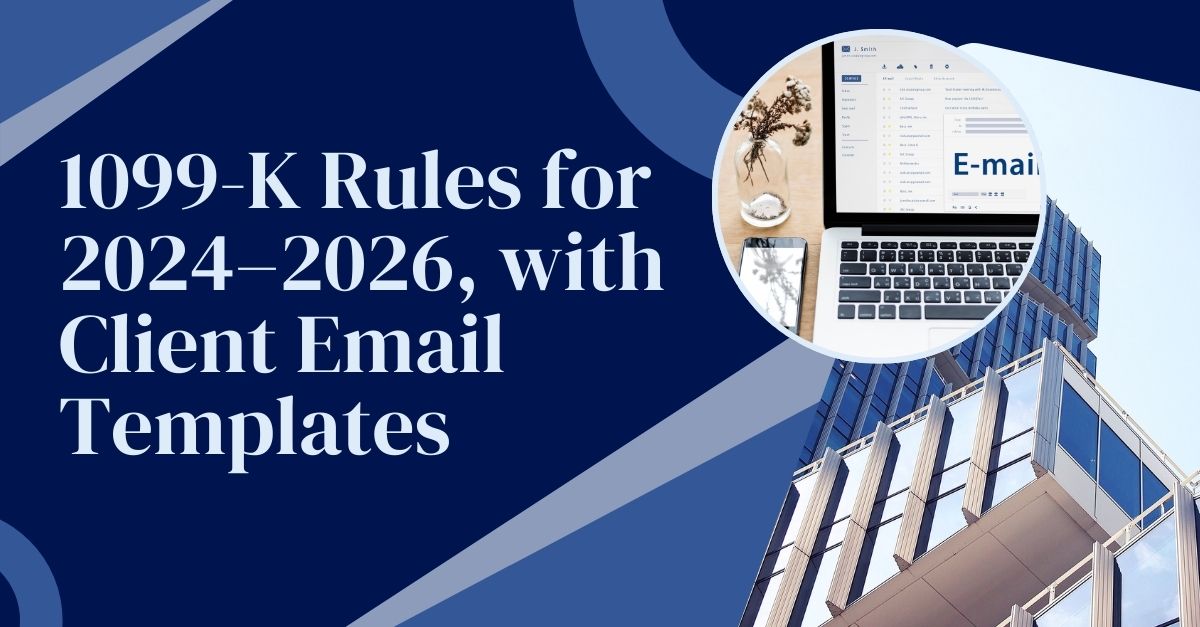For EA solos, small CPA firms, and the accountants who wish clients would just read one email.
If you are an EA or a small CPA firm, you know the drill: the IRS changes a reporting rule, and suddenly your inbox is full of panicked subject lines like “Got a strange form from PayPal… and we need help!!!”
That strange form? Form 1099-K. And over the next three years, it’s about to land in the mailboxes of millions of taxpayers who’ve never seen it before. Clients will think they are being taxed on birthday gifts, roommate reimbursements, or a handful of eBay sales. You’ll be stuck explaining again that the form itself isn’t the tax, but the reporting of payments through apps like Venmo, PayPal, Cash App, Etsy, and Uber.
The problem isn’t the tax code, it’s the confusion. And confusion eats up your time, your staff’s patience, and your ability to focus on higher-value work.
The solution? Clarity. By understanding the phased 1099-K thresholds for 2024, 2025, and 2026 and by equipping yourself with client-ready email templates, call and checklists, you can turn a reporting headache into a trust-building moment with your clients.
This guide strips away the jargon, explains what’s really changing, and hands you copy-paste communication templates so you don’t have to reinvent the wheel every time a client calls in panic.

1099-K in 60 Seconds: What It Is, Who Files, Who Gets It
Before we wade into thresholds, here’s the simplest way to explain 1099-K to clients:
- What it is: A form that reports gross payments received through payment apps, marketplaces, and card processors.
- Who files it: The payment platforms (called TPSOs) like PayPal, Venmo, Etsy, Uber, or Shopify. They send the form to the IRS and the payee.
- Who gets it: Anyone who meets the annual reporting threshold for goods and services payments.
The catch? Box 1a on the form shows gross payments, before platform fees, refunds, or chargebacks. That is why reconciling these forms to actual taxable income is essential. Otherwise, your client can get risk while paying tax on money they never kept.
The Thresholds by Year: 2024, 2025, and 2026
Here is the reason where things get messy. The IRS is phasing in the thresholds rather than immediately applying the $600 rule to everyone.
- 2024 → Threshold is $5,000 in total goods/services payments.
- 2025 → Threshold drops to $2,500.
- 2026 and beyond → Threshold plummets to the statutory $600 (unless Congress intervenes).
Why the phase-in? The IRS has stated that platforms required time to adjust their systems, and also taxpayers need time to become habitual to the new forms.
Examples from the Real World: How It Works in Daily Life
Example 1: The Venmo Crafter
| Emma sells handmade jewellery at local fairs and sometimes gets paid via Venmo. In 2024, she sells $6,000 worth, mostly through Venmo business transactions. Venmo sends her a 1099-K. Box 1a reflects 6,000, though Emma only pocketed 5,600 of this after the platform fee and a refund.
The CPA should change Box 1a to her books and should deduct the fees/refund amount of $400 and record the right amount of gross income of $5,600 on her Schedule C. |
Example 2: The Roommate ReimbursementsJohn pays his $1,200 rent share each month via Venmo to his roommate. Venmo mistakenly classifies it as “goods and services.” John also makes $400 selling old books online. Venmo issues him a 1099-K for $14,800 ($1,200 × 12 months + $400). But those rent reimbursements aren’t taxable. His EA has to separate the $14,400 in personal reimbursements and prove only $400 was taxable income. Without documentation, John could have to face an unnecessary IRS notice. |
Example 3: The Uber DriverIn 2024, Maya works as a half-time with Uber Eats and then earns $12,000. Uber provides her with a 1099-K of gross payments. Her CPA reconciles it with Uber’s driver reports to net out mileage, fees, and expenses. Even though Maya is already a small business, the new thresholds make sure her side hustle is fully reported, meaning she can’t “forget” to report Uber income without triggering a mismatch. |
The Confusing Edge Cases (and How to Explain Them)
Clients will call you about these — guaranteed.
- Personal transfers (gifts, reimbursements, roommate rent): Not taxable. But they might still show up on a 1099-K.
- Solution: Ask for transaction details and request a corrected form if possible. Otherwise, document with a memo and screenshots.
- Selling personal items at a loss: Selling your used couch for $200 when you paid $800 isn’t taxable. But platforms may still issue a 1099-K.
- Solution: Document the original cost. No taxable gain exists.
- Multiple platforms: A gig worker on Uber and Etsy may get two 1099-Ks.
- Solution: Reconcile them separately — don’t just lump together totals.
- Zelle: Currently does not issue 1099-Ks.
- Solution: Remind clients that income is still taxable — “no form doesn’t mean no tax.”
- Backup withholding: If a platform had a TIN mismatch, they might withhold 24% and report it.
- Solution: Verify with Form 945 records and credit withheld tax properly.
How to Reconcile a 1099-K Step by Step
Here’s the workflow to train staff on:
- Get the 1099-K(s): Collect PDFs from clients.
- Obtain platform reports: Gross payments, fee statements, and refund/chargeback logs.
- Reconcile Box 1a: Tie the total to platform gross reports.
- Deduct fees/refunds separately: You can enter fees as your business expenses, not as an offset against gross receipts.
- Exclude non-business payments: You have to exclude document reimbursements/gifts.
- Prepare a memo: If corrected forms aren’t issued, keep documentation in the file for IRS support.
Templates You Can Use TodayClient Email (General)Subject: What to Do If You Receive a 1099-K This Year Hi [Client Name], You may receive a new IRS tax form called Form 1099-K this year. Services like PayPal, Venmo, Etsy, Uber, or Cash App may send you these forms if your payments surpass a fixed certain threshold. Important notes:
Thresholds are changing:
Please upload any 1099-Ks to your client portal, along with notes about personal vs business payments. We’ll take it from there. Thanks, |
Wrapping Up
The 1099-K modifications implemented between 2024 and 2026 are not merely tax modifications, but mark the IRS as working to keep up with the digital economy. What would have been casual transactions with small volumes on applications such as PayPal or Venmo is now squarely under the radar of the IRS.
To taxpayers, the transition can be overwhelming initially, particularly to those who have never been a recipient of a 1099-K. However, the gradual increases of the thresholds, i.e., 5000 at 2024, 2500 at 2025, and 600 at 2026, will allow individuals and businesses time to prepare instead of rushing.
To the accountants and tax professionals, the change is actually an opportunity. With clear client emails, edge cases, which firms can address by sending out clear client emails, and updating intake checklists, firms can transform confusion into confidence. When the clients know the rules, they will rely on your knowledge more and trust you more as the forms begin to appear in their mail inboxes.
Finally, the tax season does not necessarily have to be 1099-K. It can be another tool which can be used to sure that compliance is achieved and clients can be assured in handling their financial story through active planning and clear communication with a handful of ready-to-use templates.
Frequently Asked Questions
Q1: Do I pay tax on everything that is listed on my 1099-K?
No, you dont need, the form is all about gross payments. You are only taxed on net income after adjusting for refunds, fees, and expenses.
Q2: What if my 1099-K includes personal transfers, like rent or gifts?
Those are not taxable, but the platform may have included them anyway. Keep records so we can exclude them when preparing your return.
Q3: Why did I get both a 1099-NEC and a 1099-K?
This happens when clients pay you through different methods (e.g., direct contract + PayPal). We reconcile both forms so you don’t double-report income.
Q4: I sold personal items on Facebook Marketplace. Do I owe tax?
If you sold at a loss (like reselling a sofa for less than you bought it), it’s not taxable. But if the platform issues a 1099-K, we’ll need documentation.
Q5: Does Zelle issue 1099-K forms?
No. Because Zelle transfers money directly between banks, it doesn’t fall under the IRS rule for TPSOs.
Q6: What happens if I ignore a 1099-K?
The IRS also gets a copy. If you don’t reconcile it properly, it may trigger a mismatch notice or audit.








